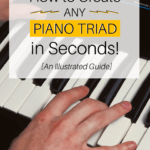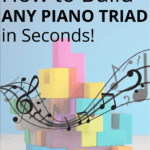Last Updated on July 10, 2022 by Rebecca
Disclosure: Please note that this article contains affiliate links, and that means that I may earn a commission if you buy something through my links. Read my full disclaimer here.
The 4 types of piano triads every pianist should know: major, minor, diminished, and augmented. Learn how to build these piano chords on any note!
There are a ton of chords in music. So how's a beginner supposed to know where to start?
The best place to start is (as usual) with the basics. And when it comes to chords, that means triads.
There are 2 main ways to learn how to build triads. The first is to use the 1st, 3rd, and 5th scale degrees, and the second is to count semi-tones.
This post will explain how to build triads by counting semi-tones.
I prefer this strategy for beginners because it doesn't require you to have your scales and key signatures memorized. All you need to remember is how many semi-tones to count for each type of triad.
Scroll down to the bottom and you'll even find a free downloadable triad-building cheat sheet to help you remember the formula for each type of triad.
Why Learn Piano Chords?
Chords are literally everywhere in music. Master your chords, and you're one step closer to mastering everything!
In it's most basic form, music is a melody. And chord shapes are often used to create melodies.
To make music a bit “fancier,” you add harmony to the melody. How do you do this? By using chords and chord shapes to accompany your melody.
So what, exactly, will learning piano chords enable you to do?
- compose your own music
- improvise your own music
- read lead sheets
- read chord charts
- accompany a sing-along or musicians on other instruments
- sight-read sheet music more efficiently
- jam with other musicians
I mean, you don't have to learn your chords… but with such a hefty list of benefits, why wouldn't you want to learn them?!

So let's dive in!
No time to read this article right now? Pin it for later!

What Are Tones and Semi-Tones?
Semi-Tones (also called Half-Steps)
A semi-tone (also called a half-step) is the distance from one key on the piano to another key immediately beside it, usually from a white key to a black key, or vice versa. For example, Eb to E is a semi-tone, and G# to G is also a semi-tone.
Sometimes, a semi-tone moves from a white key to a white key. For example, B to C, and E to F.
A semi-tone will never move from a black key to a black key.

A bit of extra theory: a semi-tone always involves 2 notes that can be described using the same letter name. The only thing that changes is the accidental (sharp, flat, or natural). And yes, this logic applies even when a semi-tone moves from a white key to another white key! For example, the semi-tone from E to F can also be described as E to E# or Fb to F.
Whole Tones (also called Whole Steps)
A whole tone (also called a whole step, or simply a tone or a step) is equal to 2 semi-tones, and it moves from one letter name to the next. A whole tone usually moves from a white key to another white key, or from a black key to another black key. For example, C to D, or G# to F#.
Sometimes a whole tone moves from a white key to a black key, or vice versa. For example, Bb to C, or F# to E.

What Is an Interval?
When you combine 2 notes, it's not usually called a chord. It's called an interval. An interval is the distance between 2 notes.
As a beginner learning basic piano chords, there are only 2 intervals you need to understand: the major third, and the minor third.
A third is any interval that involves 3 letter names. For example, the distance from C to E is a third, because if you start on C and count up to E, you count 3 letter names (C, D, and E). Basically, you just skip a letter to make an interval of a third.
But there are actually 2 different kinds of thirds!
Major Thirds
A major third consists of 4 semi-tones. For example, if you start on C and count up 4 semi-tones (1: C to Db, 2: Db to D, 3: D to Eb, 4: Eb to E), you land on E, so the distance from C to E is a major third.

Minor Thirds
A minor third consists of 3 semi-tones. For example, if you start on C and count up 3 semi-tones (1: C to Db, 2: Db to D, 3: D to Eb), you land on Eb, so the distance from C to Eb is a minor third.

What Is a Triad?
Chords are built by combining notes.
The most basic type of chord is called a triad.
A triad is a chord built by stacking 2 intervals of a third on top of each other to combine 3 notes.
Typically, we think of chords as notes played simultaneously, but there are actually lots of different ways you can play chords.

What Are the 4 Types of Triads?
There are 4 different types of triads: major triads, minor triads, diminished triads, and augmented triads.
The different types of triads are built by combining different types of thirds in different orders.
Major Triads
A major triad is built by stacking a minor third on top of a major third.
So you start on your root note, count up 4 semi-tones to add the note a major third above it, then count up more 3 semi-tones to add the note a minor third above that.
For example, in a C major triad, you would start on C, then add an E, then add a G.
This formula of 4 + 3 can be used to build a major triad starting on any note on the piano.
The chord symbol for a major triad is simply the uppercase letter of the root note of the chord. So for example, the chord symbol for a C major triad is C.

Minor Triads
A minor triad is built by stacking a major third on top of a minor third. (The opposite of a major triad.)
So you start on your root note, count up 3 semi-tones to add the note a minor third above it, then count up another 4 semi-tones to add the note a major third above that.
For example, in a C minor triad, you would start on C, then add an Eb, then add a G.
This formula of 3 + 4 can be used to build a minor triad starting on any note on the piano.
The chord symbol for a minor chord is the uppercase letter of the root note of the chord, followed by a lowercase m, without any space between the 2 letters. For example, the chord symbol for C minor is Cm.

Diminished Triads
A diminished triad is built by stacking 2 minor thirds on top of each other.
So you start on your root note, count up 3 semi-tones to add the note a minor third above it, then count up another 3 semi-tones to add the note a minor third above that.
For example, in a C diminished triad, you would start on C, then add an Eb, then add a Gb.
This formula of 3 + 3 can be used to build a diminished triad starting on any note on the piano.
The chord symbol for a diminished triad is the uppercase letter of the root note of the chord, followed by a degree symbol, with no space between them. For example, the chord symbol for C diminished is C°.

Diminished triads are also sometimes represented with the abbreviation dim. For example, a C diminished triad is sometimes represented with the symbol Cdim.
Augmented Triads
An augmented triad is built by stacking 2 major thirds on top of each other.
So you would start on your root note, count up 4 semi-tones to add the major third above it, then count up another 4 semi-tones to add a major third above that.
For example, to build a C augmented triad, you would start on C, add an E, then add a G#.
This formula of 4 + 4 can be used to build an augmeted triad starting on any note on the piano.
The chord symbol for an augmented triad is the uppercase letter of the root note of the chord, followed by a + symbol, with no space between them. For example, the chord symbol for a C augmented triad is C+.

Augmented triads are also sometimes represented with the abbreviation aug. For example, a C augmented triad is sometimes represented with the symbol Caug.
Which Triads Are Most Common?
Major and minor triads are significantly more common than diminished and augmented triads.
So while it's useful to know about diminished and augmented triads, there is a lot of music you can learn without ever using diminished and augmented triads!
Which Triads Should a Beginner Start With?
As a beginner, you really don't need to worry about practicing diminished and augmented triads just yet. It's a much better use of your time to master the major and minor triads.
But that doesn't really narrow it down much for you, since there are 12 major triads and 12 minor triads to be learned. (Actually 15 of each, if you count enharmonic keys, but that's a tale for another day!)
So let's narrow it down even more and make things really manageable for you!
The first 4 piano triads you should master are C, G, F, and Am.




There are literally hundreds of songs you can play using only these 4 chords! (Don't believe me? Check out this post about the I-V-vi-IV chord progression.)
And they are also really easy chords.
All of them include only white keys, which means they are easy to remember, and they involve the exact same hand shape. So they feel the same to play, and each one will re-enforce that hand shape to help you build up your muscle memory.
Want an Easy Way to Remember Major, Minor, Diminished, and Augmented Triads on the Piano?
To help you understand (and remember!) how the 4 types of triads work, I've created printable piano triad cheat sheet that outlines the names, symbols, and formulas for each type of triad, and also includes a sample diagram to illustrate each one.
Download it, print it, and keep it by your piano for a quick and easy reference guide!
(The cheat sheet uses C triads as examples, but remember that the same formulas apply to any triad beginning on any note.)
Next Steps
Once you understand the theory behind the triads, you'll be ready to start putting your new knowledge into practice by playing the triads at your piano!
Related Posts
- Hundreds of songs are created using only the I-V-vi-IV chords
- Halloween piano improvisation video tutorial
- How to Practice Piano Chords
- 5 Christmas Chord Progressions to Improve your Improvisation Skills Any Day of the Year
- How to play dominant seventh chords!
Share Your Thoughts
What's the first piano chord you ever learned? And what's the most valuable thing you've learned from this post?

![how to build any piano triad in seconds! [illustrated guide]](https://rebeccaspianokeys.com/wp-content/uploads/2019/11/How-to-Build-ANY-Piano-Triad-in-Seconds-3-1024x576.png)


